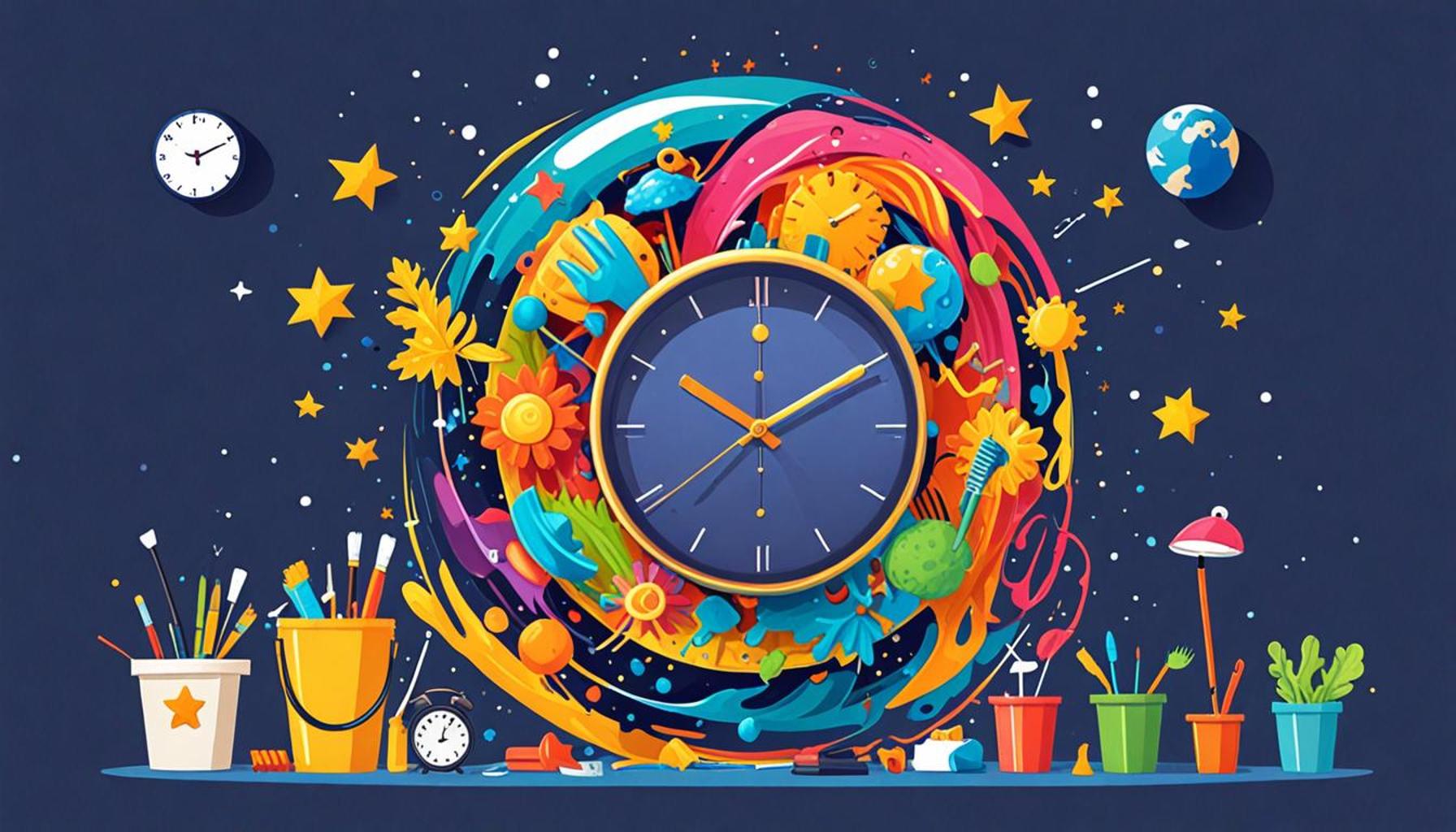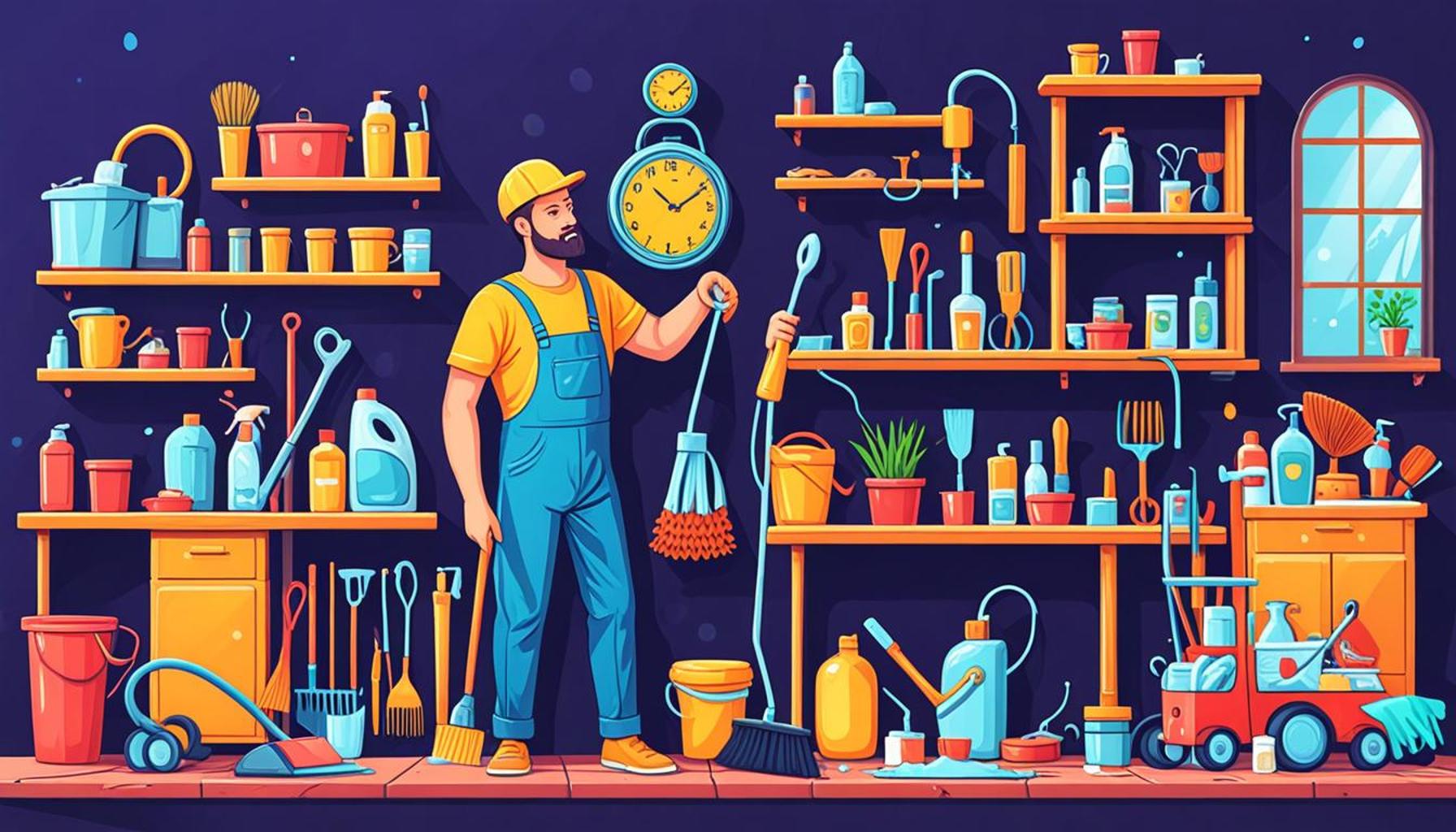The influence of the environment on productivity: how space affects time management during cleaning

The Influence of Environment on Productivity
Our surroundings significantly shape our productivity levels. When it comes to tasks such as cleaning, the space we inhabit can either enhance or hinder our efficiency. Understanding this connection can be the key to effective time management.
Consider the following factors that impact productivity during cleaning:
- Clutter: A disorganized environment can lead to distractions and delays. Research indicates that individuals often find it difficult to concentrate in cluttered spaces, as visual chaos can overwhelm the brain. For instance, a 2011 study from Princeton University found that clutter negatively affects our ability to focus and process information, illustrating the need for a tidy environment to enhance efficiency.
- Lighting: Proper lighting can energize the work process, while dim spaces may foster fatigue. A well-lit area with natural light can improve mood and energy levels, making cleaning tasks feel less daunting. In contrast, studies show that poor lighting can lead to eye strain and decreased productivity, causing one to fatigue faster. Strategically placed lamps or the use of light colors on walls can create a vibrant atmosphere that inspires efficiency.
- Layout: An intelligently arranged space minimizes unnecessary movement and maximizes efficiency. A logical layout that places cleaning supplies within easy reach saves time and effort during your cleaning routine. For example, keeping a designated cleaning caddy stocked with essential items allows you to move with speed and purpose, making the cleaning process smoother and less labor-intensive.
Interestingly, studies suggest that individuals spend up to 30% of their time managing their environments instead of completing tasks efficiently. This phenomenon raises important questions: How does the design of our spaces influence our time management? What strategies can we implement to optimize our cleaning routines?
Exploring the intricate relationship between the environment and productivity offers valuable insights into how we can streamline our daily tasks. By recognizing how space affects our habits, we can cultivate settings that foster focus and effectiveness. For example, implementing a regular decluttering schedule and utilizing storage solutions can create an organized living space that promotes productivity and reduces the mental load associated with cleaning.
Delving deeper into this topic could unveil practical tips that empower us to conquer our cleaning challenges with greater ease. Whether it’s adjusting the lighting, reorganizing furniture, or merely decluttering, taking control of our surroundings can profoundly impact our efficiency and overall well-being.

DISCOVER MORE: Click here to learn how family involvement can enhance your cleaning routine</p
Understanding the Space-Time Connection
The relationship between our environment and productivity is profound, especially when tackling tasks like cleaning, which can often feel overwhelming. Research highlights how specific environmental factors can shape the way we manage our time and execute our cleaning routines. By examining these elements closely, we can better understand how to create our spaces for maximum efficiency.
Clutter is a significant disruptor of productivity. The human brain struggles to process visual information when surroundings are overloaded with items, leading to increased stress and reduced capability to focus. A cluttered home can extend the time spent on cleaning as one might find themselves distracted or unsure of where to begin. A study conducted by the National Institute of Mental Health showed that disorganization not only creates cognitive overload but can also evoke anxiety, which further detracts from effective time management. Consequently, investing time in decluttering can yield substantial returns in productivity.
Moreover, the role of lighting cannot be overlooked. Effective lighting can have a considerable impact on our mood and energy levels while cleaning. A well-lit space can invigorate our spirit, making tedious chores feel less burdensome. Conversely, inadequate lighting not only poses safety risks but has also been shown to slow down our task completion rates significantly. A survey by the American Society of Interior Designers found that a majority of respondents reported feeling more focused and productive in spaces filled with natural light. Bringing in light through windows, mirrors, or bright paint choices can transform a cleaning endeavor from a chore into a more pleasant experience.
Another critical aspect is the layout of the cleaning space. An organized layout that prioritizes accessibility can save precious time. When cleaning supplies are stored in a way that they are easily retrievable, the process becomes more fluid. Creating a system, such as a cleaning caddy suited for various tasks, ensures that all essential items are within arm’s reach, thereby eliminating unnecessary trips back and forth. This strategic arrangement not only optimizes the time spent cleaning but also keeps one in a mindset of productivity.
Understanding that individuals may be spending around 30% of their time simply navigating their environments captures the essence of why such details matter. This data highlights the importance of reshaping our physical spaces to cut down on inefficiencies. Strategic decisions about spatial organization can have a ripple effect on our day-to-day time management during cleaning.
As we delve deeper into practical strategies for optimizing our cleaning routines, considering factors such as color, noise levels, and even personal touch can further enhance the effectiveness of our environments. By uncovering how our spaces influence our cleaning habits, we are well on the way to crafting settings that not only encourage productivity but also foster a sense of calm and control.
The relationship between our physical environment and productivity is a subject of great interest within the realms of psychology and organizational behavior. Research consistently supports the notion that spatial design profoundly impacts our efficiency, especially during cleaning activities. For instance, natural lighting has been shown to boost mood and energy levels, leading to improved focus and stamina. In environments where cleaning is frequent, ensuring that spaces are well-lit can not only enhance visibility but also create an inviting atmosphere that may encourage rapid action.
Additionally, the arrangement of furniture and the accessibility of cleaning supplies play pivotal roles in how effectively time is managed during cleaning tasks. A cluttered space often translates to a cluttered mind, which can inhibit productivity. By implementing strategic organization, individuals can navigate their cleaning routines more efficiently, significantly reducing the time taken to complete tasks. The concept of “zones” in cleaning—designating specific areas for different tasks—can also streamline the process, allowing cleaner spaces to be maintained consistently.
Moreover, incorporating elements of biophilic design, such as plants and natural materials, into cleaning environments has been correlated with increased productivity. These elements not only elevate aesthetics but also contribute to a calming atmosphere that can reduce stress, making the cleaning process feel less burdensome. Maintaining a clean and organized space fosters a sense of accomplishment that can positively impact overall time management during cleaning.
Eco-consciousness is also gaining traction in workspaces, promoting sustainable practices during cleaning. Utilizing environmentally friendly products can reduce harmful exposure while enhancing employee wellbeing, directly affecting productivity. Such approaches are vital as they not only respect the environment but also create healthier atmospheres for individuals engaged in cleaning routines.
| Environmental Factors | Impact on Productivity |
|---|---|
| Natural Lighting | Enhances mood and energy levels, leading to improved focus. |
| Furniture Arrangement | Clutter-free designs enhance navigation, reducing cleaning time. |
| Biophilic Elements | Create a calming effect, decreasing stress during cleaning. |
| Sustainability | Reduces harmful exposure while promoting eco-friendly practices. |
DISCOVER MORE: Click here for tips on organizing your cleaning products
Creating an Enabling Environment for Cleaning Efficiency
To further enhance our understanding of how environmental factors impact productivity during cleaning, we must consider the psychological and sensory elements of our spaces. The influence of color is particularly noteworthy. Studies indicate that colors can evoke specific emotions, which might be beneficial or detrimental depending on the task at hand. For instance, lighter colors such as blues and greens are commonly associated with calmness and relaxation, potentially making the cleaning process feel less daunting. In contrast, brighter colors like yellows and oranges can stimulate energy and motivation. Selecting an optimal color palette for cleaning spaces can create a mood that favors completion and efficiency.
The presence of noise levels in the environment also plays a crucial role. A quiet environment allows individuals to concentrate on their cleaning tasks, whereas background noise can lead to distractions and increased time spent completing chores. Research from the University of California, Irvine, found that even minor disruptions in a workspace can derail focus, leading to longer completion times for tasks. On the other hand, ambient sounds like soft music or nature sounds can enhance moods and potentially improve overall productivity. Experimenting with various soundscapes while cleaning can help individuals find what best supports their cleaning rhythm.
Moreover, incorporating elements of personalization into the cleaning space can further increase motivation. Surrounding oneself with items that evoke positive emotions, such as family photographs or favorite artwork, can create an inspiring atmosphere that makes cleaning feel less like a chore and more like a personal project. This emotional connection to the environment can spur individuals to tackle their cleaning tasks with heightened enthusiasm, translating into more effective time management and higher productivity levels.
It’s worth noting that the functionality of cleaning tools and supplies directly affects efficiency. High-quality, ergonomically designed tools can reduce physical strain, allowing for quicker and more effective cleaning. For instance, using a vacuum cleaner that is lightweight and easy to maneuver can decrease the effort needed to clean various surfaces, thus saving time. Investing in efficient tools designed for specific tasks, such as microfiber cloths for dusting or effective cleaning solutions for hard surfaces, allows individuals to maximize their time spent on cleaning activities.
Additionally, the significance of having a designated cleaning schedule cannot be understated. Structure within our environment greatly supports our ability to manage time. Creating a routine can establish a rhythm that not only streamlines the cleaning process but also reduces decision fatigue—one of the key reasons that cleaning can feel overwhelming. Designating specific days or times for various cleaning tasks can help cultivate habits that turn cleaning into a less time-consuming task.
Lastly, to highlight the connection between our environment and productivity on a broader scale, consider the findings from a study published in the Journal of Environmental Psychology, which noted that individuals in well-organized and aesthetically pleasing spaces reported a 25% increase in their productivity levels. These insights affirm the necessity of crafting our environments with intention, as even small changes can lead to remarkable improvements in how effectively we manage our time, particularly during cleaning.
DISCOVER MORE: Click here to learn how to adjust your maintenance schedule
Concluding Thoughts on Environmental Influence and Cleaning Productivity
In conclusion, the impact of environmental factors on productivity during cleaning is undeniable. From the colors that adorn our spaces to the noise levels that surround us, each element contributes to our overall efficiency and time management. As highlighted throughout this article, creating a space that fosters motivation and minimizes distractions can transform the often-daunting task of cleaning into a manageable and even enjoyable routine.
Moreover, the importance of personalization cannot be understated; by infusing our cleaning environments with elements that inspire us, we cultivate an emotional connection that enhances our willingness to clean. Practical elements such as ergonomically designed tools and a well-structured cleaning schedule further streamline the cleaning process, proving that a thoughtful approach to cleaning can yield substantial benefits in saving time and increasing productivity.
As we consider the findings of the Journal of Environmental Psychology, which indicates that a well-ordered environment can improve productivity by 25%, it becomes clear that optimizing our spaces is not merely about aesthetics but a proactive strategy for enhancing our daily lives. By intentionally crafting our cleaning environments, we can reshape our relationship with this essential task, leading to not only cleaner homes but also a more organized and efficient lifestyle. In essence, reevaluating our surroundings may just be the key to unlocking new levels of productivity in our cleaning routines.


